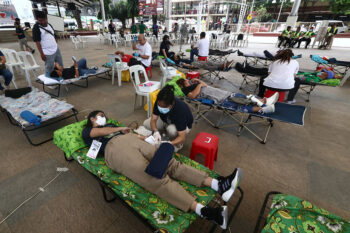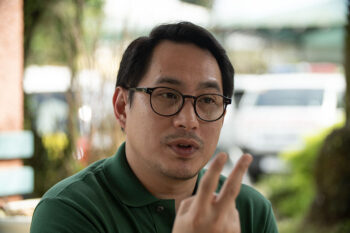
CEBU CITY (MindaNews / 13 April) — April 13, today, is the birthday of Fr. Rudolfo “Dong” Galenzoga. He turned 76 today. This essay was written to honor his memory.
Sometime in mid-March 2021 – when the COVID-19 pandemic was still claiming victims – Fr. Rudolfo (more popularly known as Dong) Galenzoga succumbed to complications owing to pneumonia. Earlier, he, too, was infected with the COVID-19 virus and had to be hospitalized. Unfortunately after he had recovered from the virus, complications arose and he did not survive the death-dealing blow. He would have turned 76 the following April 13.
His burial took place on March 19, Feast of St. Joseph, after the mass presided by Iligan Bishop Jose Rapadas. Today his remains lie in peaceful slumber on a hill overlooking Panguil Bay with the majestic Mt. Malindang serving as backdrop. This place which he had named Dapit-Alim (Place for Healing) is located between the towns of Kolambugan and Tubod in Lanao del Norte. Here on this hill, the faithful from the nearby villages gather together for rituals.
In many occasions during the past years, especially during the Holy Week, Dapit-Alim was transformed into a theatre in-situ as a series of plays – constituting the narratives across Christ’s Passion, Death and Resurrection – unfolded in a full week of dramatizations. Dapit-Alim has become Mindanao’s equivalent of the famed Oberammergau Passion Play — a passion play that has been performed every 10 years since 1680 by the inhabitants of the village of Oberammergau, Bavaria, Germany.
For a number of years since Fr. Dong decided to permanently live in Dapit-Alim, he gathered together the simple folks of this and neighboring villages to rehearse and – during the Holy Week – perform various scenes from the narrative of the Passion story. The different scenes were staged at various sites of Dapit-Alim, culminating on the crucifixion scene at the highest spot of this hill. These were then incorporated into the liturgical services on these important dates of the Catholic calendar year. Crowds from far and wide would gather on the Dapit-Alim hill to not just be spectators but participants in what are immersive-oriented theatrical performances.
The legacy of Fr. Dong – who today is acknowledged as a peacebuilder, interfaith dialogue icon and Mindanao theatre pioneer – has been passed on to young Mindanawons who have been inspired by his long years of commitment to justice and peace, human rights and ecological advocacies, inter-faith dialogue as well as in exploring theatrical expressions that reflected the beauty of Mindanawon cultures, combining the – Moro, Lumad and migrant settlers’ aesthetics.
His life journey began from his childhood spent in the backwater town of Tubod, situated along the coast of Panguil Bay. As his family’s house is just adjacent to the parish church and coming from a deeply religious family, it was almost a taken-for-granted fact that he, the youngest member of a rather large family, would soon enter the seminary and be ordained as a priest.
The last stage of his seminary formation at the San Jose Theological Seminary in Quezon City (administered by the Jesuits) provided Fr. Dong the experience that would lead him to the world of theatre. At that time it was already a practice for seminarians to have weekend exposure visits to the most disadvantaged sectors around Metro Manila. He found himself spending time with the physically challenged with hearing and speaking disabilities at the School of the Deaf and Mute along Harrison St., Pasay City.
There he learned sign language with the movement of hands and facial expressions providing the persons with disabilities with the possibility of being able to communicate with one another. Fr. Dong saw the potential of these movements in creating theatre and before long, he had the students in this school doing play improvisations. This actual experience plus his early interest in the field of arts would serve him well after his ordination in 1969, especially when he got assigned to Kolambugan.
An alumnus of San Jose wrote an essay which appeared in Insta, the official publication of the seminary indicating that: “The war in the 1970s and the declaration of martial law ‘contextualized’ Galenzoga’s priesthood.” To recall the situation in Muslim Mindanao in the late 1960s to the 70s, outbreaks of violence erupted between the Ilagas and the Blackshirts, later shifting to the war between Moro rebels and government forces.
Kolambugan, being a port town – where ferry boats traversed between this town and Ozamis City – held a most strategic location in this part of Lanao. Situated along an important highway connecting Iligan City to the rest of Lanao and beyond, it was bound to suffer the consequences of the tragic violence of this inter-ethnic warfare and Moro rebellion. When encounters took place between the contending forces, civilians were bound to suffer the consequences and not just the combatants. Bakwits were a common sight during these turbulent times.
In conversations Fr. Dong had with friends, he recalled the days when he helped collect goods and distributed to those displaced from their homes, bring the wounded to the hospitals and comforted the relatives of the dead. He also related how late at night – after a long day of being with the wounded and the dead – he would be haunted and couldn’t sleep. There were even nights when he could hear moaning inside the church as if the souls of the dead were demanding prayers so they could rest in peace!
In an interview later on, Fr. Dong gave this account: “We were in the midst of our people’s high hopes in their struggle for justice and peace. Indeed, my early years in the ministry were of deep joy and creativity, but also of pain and paralyzing fear. There was so much violence, injustice and hate brought by the senseless violations of human rights. However, those years were also times of intense hope for the country, faith in the goodness of human nature, and above all, trust in the abiding presence of God even in the darkest night…I will never forget the hundred and one burned and mutilated dead bodies of both Muslims and Christians, the thousand and one faces of horror, hunger and despair of evacuees. I will forever remember with deep gratitude the friends and companions who generously and valiantly offered their lives in the struggle that our people may someday reach the Promised Land, Mindanao.”
This deep sense of faith and intense hope would drive Fr. Dong to a level of creativity that would lead to theatrical productions, providing a new direction for Mindanao theatre. Being the parish priest of Kolambugan, he tapped into the talents of the ordinary folks who constituted the first members of his theatre group. His initial efforts in this genre led to the performances of the ground-breaking musical play Maranatha, today considered a classic.
Based on an old Lanao folk tale about a big, black, predatory bird that caused a fragmentation among the people, the story served to expose corruption of politicians and the growing militarization in Mindanao. Combining classical music with indigenous dance movements, mime and spoken words, Maranatha proved to provide the language that spoke of the people’s grief and their longing for peace. Word got around and before long, there was a popular demand to stage Maranatha across Lanao and neighboring provinces.
Between 1974 and 1975, Maranatha made over 135 performances as it went on a nationwide tour. It would later be re-staged at various time periods. It was also toured at the time when Fr. Dong served as chaplain of Mindanao State University. It was performed by the MSU-CSO (Mindanao State University-Catholic Students Organization) students in the early 1990s in the cities of Zamboanga, Cotabato and Jolo with a mixed cast of Muslims and Christians. The dance-drama was re-titled “Kalilintad Anda Ka” (Peace Where Are You?).
Fr. Dong updated Maranatha in 2018 and renamed it Bangaw Mindanao. When he decided to live in Dapit-Alim, a newly-founded community brought Maranatha to some towns and cities of the Visayas and Mindanao in the early 2000s. As the movement of inter-faith dialogue and peacebuilding progressed in Mindanao with the intermittent peace negotiations, Maranatha served as the cultural expression of the desire of all Mindanawons – Moro, Lumad, Christian settlers – for peace which had remained elusive for decades!
Meanwhile, as parish priest, Fr. Dong pioneered the establishment of the Kristohanong Katilingban (KRISKA) program, organizing Catholic households into cells where they gathered together for bible sharing and liturgical celebrations. In his own parish, Fr. Dong introduced many inculturated forms of liturgy, incorporating choreography into his Masses. Out of this evolved a liturgical play he labelled Misa ng Bayan. A counterpart of Boni Ilagan’s Pagsambang Bayan (a play that evolved out of UP-Dliiman), Misa ng Bayan showed the power of an inculturated Mass.
While touring Maranatha, Fr. Dong and his theatre group also officiated at a Mass which was the actual performance of Misa ng Bayan. A scene in this performance had the priest ordained not by the Bishop but a community of ordinary folks and like Jesus, he too, suffers the consequences of a prophetic commitment to justice and peace.
After his stint as parish priest of Kolambugan, Fr. Dong went on to head the Interreligious Dialogue ministry of both the Prelature of Marawi and the Diocese of Iligan. This also involved reaching out to the Protestants for the ecumenical aspect of inter-faith dialogue. Later he served as Executive Secretary of the Mindanao Interfaith Pastoral Conference which allowed him to go around Mindanao, giving talks, attending fora and conferences, conferring and collaborating with other NGOs on MIPC’s major advocacies (inter-faith dialogue, human rights and ecological advocacy). For his commitment in these issues, the San Jose Seminary Alumni Association in 2011 conferred on him the San Jose Award in recognition of his commitment to interreligious dialogue and service among the Muslims and Lumads of Mindanao.
In his advancing years, Fr. Dong decided that he would locate himself in a place for prayer, contemplation, meditation and retreats. With a group of trusted friends, he founded the Kahigalaan ni Jesus (KH) Dapit-Alim. This was to be a sanctuary for those who are “tired and weary, those seeking answers to faith questions and for those with a passion for inter-faith dialogue with Muslim and Lumad brothers and sisters.”
At the same time, Dapit-Alim became the site of Fr. Dong’s continuing desire to use his enormous talents in coming up with theatrical productions that speak of the Mindanawon’s heart longing for peace and harmony among a multi-ethnic, multi-language and multi-faith peoples!
Some of Fr. Dong’s fans and followers now ask if he had written accounts of his rich experiences and the deep reflections he had gained through his long years of service. They find themselves disappointed at the limited writings Fr. Dong left behind. But he did leave behind his theatrical productions – his songs and dances and the images captured in the movements of his actors. In this way, Fr. Dong remained in touch with his indigenous roots which was why he was so fascinated with Lumad cultures.
Here lies his contribution to Mindanao’s production of knowledge in the field of Humanities. Echoing the words of Diana Taylor (a professor of Performance Studies at NYU), we can situate the importance of Fr. Dong’s contribution in these words: “[W]riting has paradoxically come to stand in for and against embodiment. When the friars arrived in the New World in the fifteenth and sixteenth centuries,… they claimed that the indigenous peoples’ past – and the ‘lives they lived’ – had disappeared because they had no writing… Nonverbal practices – such as dance, ritual, and cooking… were not considered valid forms of knowledge.” (In her book The Archive and the Repertoire, p. 16-17).
If God is the Lord of the dance, Fr. Dong is out joyously joining in a company of dancers!
(MindaViews is the opinion section of MindaNews. Redemptorist Brother Karl Gaspar is Mindanao’s most prolific book author. Gaspar is also a Datu Bago 2018 awardee, the highest honor the Davao City government bestows on its constituents. He recently moved to his new assignment in Cebu City.)







